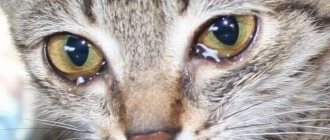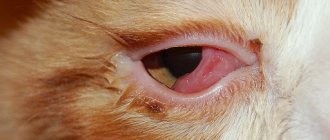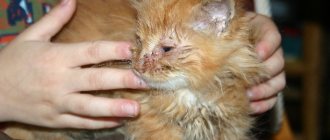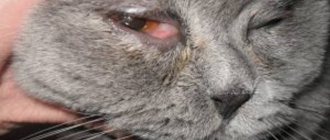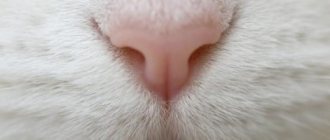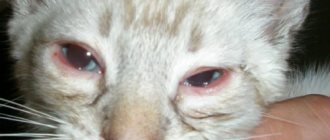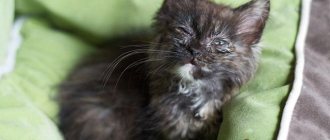Causes
The factors leading to teary eyes are varied. There are situations when it is a physiological norm.
Tears in a cat are a normal reaction of the body if:
- no swelling;
- the pupil reacts normally to light;
- the color of the discharge is transparent, without shades or impurities of pus;
- no signs of foreign objects;
- the shell has not changed color;
- the animal does not experience discomfort.
In addition, some breeds have a predisposition due to anatomical features. For example, the tear duct in the Scottish and British breeds is too short, while in the Persian it is curved. Kittens are genetically predisposed to tearfulness.
In these cases, it is enough to wipe the eyes with a sterile napkin and periodically rinse them with chamomile decoction; no additional procedures are required without changing the transparency of the tears.
Also normal is morning whitish discharge in the corners of the eyes, which is the result of the cleansing work of the lacrimal glands. The cat independently removes accumulated crusts from the eyes, but if this does not happen, the owner can help the pet with a napkin or swab soaked in saline solution or regular clean warm water.
In kittens that are just opening their eyes, increased tear production is a reaction to a physiological change that protects their delicate eyes. If the tears are transparent and not viscous, there is no reason to worry. They last no more than one week.
How to examine a cat?
Quite often, the appearance of tears in a cat's eyes indicates the presence of some kind of disease. It is important for the owner to pay attention to whether tears appeared for a limited time and then disappeared, or in the pet’s eyes the discharge is present throughout the day, or, what is much worse, not for several days.
- If the tear discharge is insignificant, appeared in the morning and quickly passed, then there is nothing to worry about, so there is no need to worry;
- If it is clear that the eyes “cry” for a long time, then you need to look for the cause of this phenomenon.
Before examining your pet, you need to clean your hands to prevent additional infection. Next, you need to pull down the upper eyelids on each eye. If the eyes are shiny and not clouded, the pupils are the same size, the cornea is noticeably transparent, and the back surface of both eyelids has a pale pink tint, then there are no problems with the animal’s eyes.
The fact that there are certain problems with the eyes can be judged by redness or swelling of the eyelids, clouding of the cornea.
If the animal’s eyes are difficult to open or there is a thin light film on the inner surface of the eyelid, then it is recommended to go to the veterinarian as soon as possible.
Pathologies
Any change in the animal's condition requires urgent contact with a veterinarian. The owner should be wary if:
- dullness and change in eye color;
- unnatural reaction of the pupil to light;
- change in the shape of the eyeball;
- the occurrence of edema;
- change in color or viscosity of the secretion,
- the appearance of purulent discharge;
- increased body temperature;
- presence of foreign bodies;
- change in color of the mucous membrane;
- runny nose;
- blood;
- strange behavior of the animal (tongue sticking out, rapid breathing, rubbing eyes).
Read the article about eye diseases in cats.
When to see a doctor
If, as a result of the injury, the cat's eye is red and watery, you should not postpone a visit to the doctor. The sooner the cat receives help, the greater the chance of preserving the animal’s vision.
Important! If there is dirty or purulent discharge from the eyes, the cat should be taken to the vet immediately!
Diagnostics in the clinic
Diagnostic methods for lacrimation in cats involve a simple visual examination and further laboratory tests. The goal is to identify the cause of discharge from the eyes and prescribe treatment if infectious or other diseases are detected. To clarify the diagnosis, stool analysis, scrapings or smears, and hardware examination of the eyes may be required.
Symptoms
If a pathological cause is obvious, all manifestations of the disease should be observed to give the doctor as complete a history as possible to ensure the best decision.
Common cat diseases manifest themselves as follows:
| Symptom | Disease and cause |
| Long and profuse tearing. | Viruses and fungi such as plasmosis: calcivirosis, mycoplasmosis, toxoplasmosis, etc. |
| Pus. | Foreign objects. |
| Edema. | Turn of the century. |
| Cloudiness. | Keratitis, cataract. |
| Black spot. | Dying of the cornea. |
| Tears are accompanied by fever, diarrhea, vomiting, and lethargy. | Feline distemper (panleukopenia). |
| Swelling with cloudiness. | Glaucoma. |
| Swelling in the corners of the eye. | Inflammation of the lacrimal glands. |
| Redness of the membranes, photophobia. | Conjunctivitis. |
| Damage to one eye. | Parasites. |
Eye diseases accompanied by the production of tears
There are several different eye conditions in pets that cause tear production:
- Infection. If the eye is noticeably swollen and red, and there is discharge of pus, then the help of a veterinarian is definitely needed to prevent the development of feline conjunctivitis.
- Directly eye diseases, in particular glaucoma or cataracts. A clouded cornea in the first case or a whitened lens in the second are the most obvious symptoms of these diseases. Of course, you definitely need to go to a clinic for treatment.
- Diseases caused by fungi or viruses (such as toxoplasmosis or chlamydia) can only be cured by a veterinarian.
- Inflammation of the cornea can be identified by reddened and very watery eyes, on which a soapy film forms.
- Some breeds experience entropion of the eyelid - usually Sphynxes or Persians. The appearance of swollen eyes and suppuration in their eyes is a reason to visit a veterinarian as soon as possible.
- Eye injuries that a cat can get if it fights with its fellow tribesmen, hits itself, or gets caught on some branches. Wounds or other damage to the eyeballs are obvious symptoms of this injury. It is recommended to consult a veterinarian to determine the severity of the damage.
What to do if your cat's eyes are watery
After the symptoms have been recorded and the first auxiliary measures have been taken, it is necessary to take the cat to the doctor.
First of all, you should tell your veterinarian about:
- age;
- behavior change;
- change in food preferences or lack of appetite;
- reactions to light;
- injuries;
- color of discharge;
- body temperature;
- timing of the last vaccination and treatment against parasites;
- change of environment for the cat.
Self-medication is dangerous and always leads to negative consequences for the animal’s health. Under no circumstances should you:
- use potassium permanganate for rinsing;
- giving an animal human medications without a veterinarian's prescription;
- take antibiotics without consulting a doctor;
The best solution before visiting the veterinarian is to rest the animal. The cat should eat a lot, drink water and stay warm.
If you haven’t had anthelmintic treatment for a long time, now is the time to do it.
Your pet should not freeze or go hungry.
Symptoms
Let's look at how allergies to cats manifest themselves. In fact, the manifestations of an allergic reaction can be of different types.
Respiratory symptoms of a cat allergy:
- nasal congestion and allergic rhinitis;
- burning sensation and itching in the throat and nose;
- cough and sneezing;
- dyspnea;
- swelling of the nasopharynx.
Against the background of these symptoms, general weakness and even fever may occur.
The intensity of respiratory symptoms varies from person to person. For some, they appear after prolonged contact with a cat, while for others, an attack can begin literally when the animal appears.
Manifestations of a skin allergic reaction to cats:
- the appearance of irritation and itching on the skin;
- burning and itching;
- rash, blistering and redness.
Skin symptoms usually appear upon direct contact with the animal. If an allergic reaction is expressed only in this way, then it will be enough for the patient to simply minimize the risks of their manifestation - it is enough to exclude contacts with felines.
Allergic manifestations of food nature:
- nausea;
- pain syndrome in the stomach.
If an allergen gets into food, symptoms can manifest themselves in this way - a general deterioration in the condition, the urge to vomit and pain in the stomach. In this case, it is also important not to delay your visit to the doctor, so that the specialist has the opportunity to make the correct diagnosis as early as possible.
Other cat allergy symptoms:
- headache;
- lethargy and irritability;
- the appearance of swelling in the eye area, profuse lacrimation.
It should be noted that all of the listed symptoms are not unique and may indicate the development of another disease. Therefore, the key point is accurate diagnosis and determination of the cause of the symptoms that appear.
Are you experiencing cat allergy symptoms?
Only a doctor can accurately diagnose the disease. Don't delay your consultation - call
Treatment
Self-medication is dangerous for your cat's health. The wrong medications can undermine it even further by attacking the microflora of the intestines, liver and kidneys. Potassium permanganate dries out the delicate mucous membranes of the eye, leading to problems including loss of vision.
The veterinarian knows best what will help the pet. To relieve irritation, the drugs Anandin, Tsiprovet, and Iris are usually prescribed. Bars eye drops can be used as a cure for infections and as a preventative hygiene product. Albucid is often used to relieve lacrimation in a kitten, but only after a prescription from a veterinarian.
For a viral infection, the doctor will prescribe chloramphenicol or tetracycline ointment. If the cause is helminths, you need to find out from the doctor how best to carry out the treatment in this case.
A radical surgical solution is rarely prescribed, for example, if a cat has an entropion of the eyelid. However, there is no need to worry ahead of time - most often, the cause is allergies and colds. In this case, the doctor will tell you how best to carry out prevention and prescribe the vitamin supplements or anti-allergy medications needed for your pet.
Be sure to read the article about vitamin deficiency in cats, because these conditions may be related.
Causes and treatment
There are several common reasons why a cat's eyes may start to water.
Some foreign body has entered the eye. It could be a speck, a twig, a fluff, a midge or dirt. If something like this is discovered, you must first rinse the pet’s eyes under running water. Once the foreign object is washed away, you can use one percent tetracycline ointment to apply to the cat's upper eyelid area. It is recommended to take the animal to a veterinarian for consultation.
The pet has a weakened immune system. This happens if the kitten was separated from its mother too early. However, only a veterinarian can reliably determine whether this is the case. He will also develop a regimen for taking the required medications and correct the pet’s nutrition.
The presence of an allergic reaction, which is inherent in cats as well as in humans. The same thing that can act as an allergen can act as a human allergen: chemicals, dust, pollen, etc. In this case, it is imperative to contact a qualified specialist for consultation, since the owner will not be able to independently determine not only the allergy itself, but also the cause of its occurrence.
Worms are a fairly common reason why a cat's eyes may begin to water. To exclude this, it is necessary to regularly treat the animal for parasites.
Pet breed. Some cat breeds have a characteristic skull structure with deformed nasolacrimal ducts and a flattened nose. In this case, only washing the eyes every day helps, as well as special attention to hygiene procedures in such a risky area.
Diseases of cold origin. If your pet coughs and sneezes additionally, absorbs a lot of water, and begins to sleep much more, then it is quite possible to suspect a cold. It is not recommended to treat the animal yourself; you need to contact a specialized specialist.
Cat distemper also has discharge from the eyes as one of its symptoms. In addition, the appearance of pus, high fever, vomiting and diarrhea, and general weakness are noted. It is not allowed to treat a pet with such symptoms on your own.
Rules for washing and instilling eye drops
If one of the points of treatment for a cat is eye drops, then it is important to know how to carry it out while causing minimal discomfort to the pet.
For this you need:
- sterile pipette or syringe;
- product (drops, ointment) at room temperature;
- clean wipes or tampons;
- food to encourage and relieve stress in cats.
It is advisable to carry out the burial with an assistant who will help hold the frightened animal. The cat must be well secured. In extreme cases, it is tied with soft cloth.
With a moistened swab, wipe the pet's eye from the outer corner to the inner, removing crusts and drops of secreted liquid. Then the eye is wiped again with a clean napkin.
Now you can start instilling: open the cat’s eyes wide with the thumb and forefinger, after which the product is quickly instilled directly under the eyelid. Excess liquid is blotted with a napkin, then the cat is rewarded for its bravery and released.
Pregnant and small pets require a special approach. Cats expecting the birth of babies are rarely prescribed medications; rinsing is done with chamomile or calendula decoctions, a tea solution, and in extreme cases, tetracycline ointment is applied. Newborn kittens with high tear production are prescribed Bars or Anandin drops.
Table of contents:
Causes of tearing Classification Symptoms and diagnosis Treatment of tearing eyes Prevention
Tearing is a natural process. The fluid secreted by the tear glands moisturizes the surface of the eye and protects the mucous membrane from dust and other particles. Excessive lacrimation occurs during inflammatory processes. It signals the development of ophthalmopathology. Treatment of tearing eyes should be carried out under the supervision of a doctor, since if treated incorrectly, the infection can lead to suppuration and deterioration of vision.
Why are my kitten's eyes running?
The following factors can cause a kitten’s eyes to run::
- The most common reason is the appearance of infections. Some of them can be infectious to humans. This is mycaplasmosis, herpes or chlamydia. The presence of a specific infection can be determined by taking an eye wash sample.
- Various types of allergies. They can manifest themselves as a reaction to dust, food, household chemicals or other irritants.
- Eye injuries. They can appear as a result of active play, when the claws accidentally get into the eyes, or due to burns. Specks getting into the eye is also one of the reasons causing injuries to the cornea or other parts of the visual organs.
- Exposure to lighting fixtures containing fluorescent lamps. The irritant in this case is a bright light source.
- Diseases of the gastrointestinal tract.
- Infection of an animal with helmites.
© shutterstock
Only a veterinarian can tell you exactly why a kitten’s eyes are watering. In this case, his conclusion will be based on the results of the analyzes. Accordingly, he will prescribe the correct treatment for the cat.
Treatment of teary eyes
If your eyes are watery, drug therapy is used for treatment. When an inflammatory process is diagnosed, a number of drugs are prescribed:
- antibiotics;
- antihistamines;
- non-steroidal anti-inflammatory drugs.
To eliminate tearing, use drops that relieve itching and swelling. For inflammatory processes, physiotherapy may be prescribed, such as phototherapy, electrophoresis, and magnetic therapy.
For dry eye syndrome, if a person has to work for a long time in the wind, in smoky or dusty rooms, or at a computer, moisturizing drops that imitate natural tear fluid are prescribed. The composition of the preparations is as close as possible to natural tears and does not cause discomfort when instilled.
Surgery is a last resort measure that is used when the tear ducts are blocked or the upper or lower eyelid is everted. If the lacrimal canal is blocked, which often happens in infants, they resort to balloon dacryocystoplasty in children or dacryocystorhinostomy.
During the first type of surgery, a guidewire with an expansion balloon is inserted into the hole in the corner of the eye and filled with fluid. Under pressure it expands the duct.
For adults, dacryocystorhinostomy is used. A new duct is created between the lacrimal sac and the nasal cavity, going around the blocked one. Laser and endoscopic dacryocystorhinostomy remain more modern and effective methods of surgical treatment of tearing.
If lacrimation occurs, it is important to promptly consult an ophthalmologist. Do not forget that the symptom may be a manifestation of an inflammatory process leading to deterioration of vision. Some pathologies with tearing lead to atrophy of the optic nerve, and sometimes blindness. Elimination of complications may require more funds.
